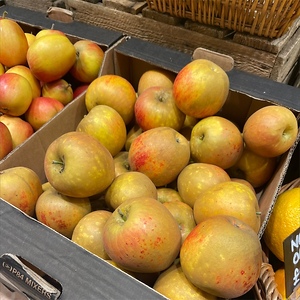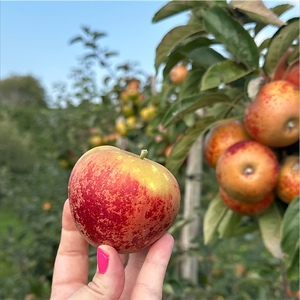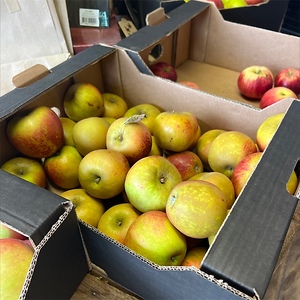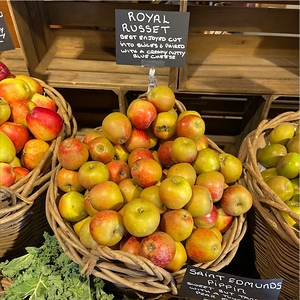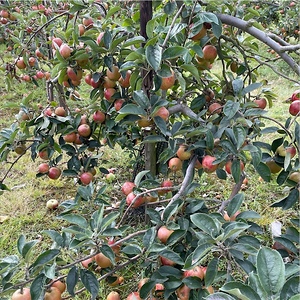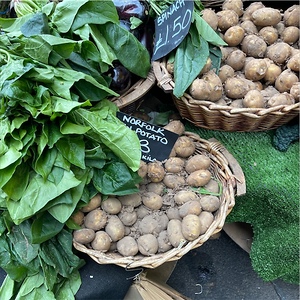

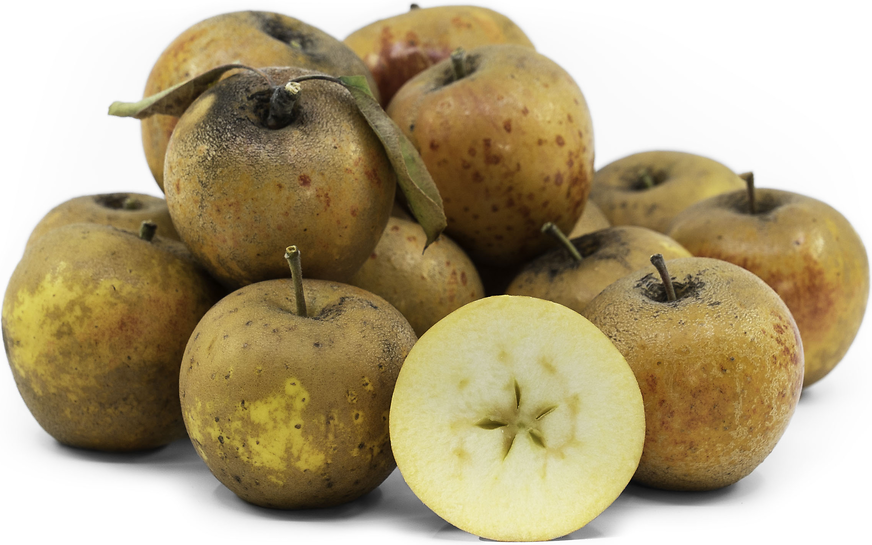
Norfolk Royal Russet Apples
Estimated Inventory, lb : 0
Description/Taste
Norfolk Royal Russet apples are a small to medium-sized varietal, averaging 5 to 5.5 centimeters in diameter, and have a round, oval, to conical shape. The apple's skin showcases a golden yellow base with large patches of dark red-orange blush and striping. Depending on the length of exposure to the sun, the blush is somewhat translucent to solid, and the striping is generally broken and mottled, comprised of streaks and spots. On exposed portions of the skin, the surface is smooth and waxy, but a notable characteristic of the variety is it's dark brown to tan russet, enveloping the majority of the fruit's surface. The russet has a rough, sandy texture along with raised lenticels, and there are dark brown striations circling the stem cap on some of the fruits. Underneath the surface, the white to ivory flesh is slightly dry, soft, and crisp with a chewy, starchy consistency. The flesh also encases a moderately-sized central core filled with tiny, tapered black-brown seeds. Norfolk Royal Russet apples have a rich, sweet, spice-filled flavor with fruity nuances of pears and floral, nutty undertones.
Seasons/Availability
Norfolk Royal Russet apples are available in the fall.
Current Facts
Norfolk Royal Russet apples, botanically classified as Malus domestica, are an English variety belonging to the Rosaceae family. The apples appeared as a sport on a Norfolk Royal apple tree in Norfolk, England, in 1983. Sports are natural, genetic mutations that generally occur on a single tree branch. The mutations can range from varying appearances, having increased disease resistance, to bearing a flavor distinct from the parent variety. Norfolk Royal Russet apples have an aromatic, sweet, fruity, floral, and nutty flavor, and the brown russet contrasts the bright red blush, creating a vibrant, enticing appearance. The sport is considered more popular for home gardens than the original Norfolk Royal apples, and the mid-season variety is mainly consumed as a dessert cultivar.
Nutritional Value
Norfolk Royal Russet apples have not been studied for their nutritional properties. Like other apple varieties, the apples are a source of fiber to regulate the digestive tract, antioxidants to protect the cells against the damage caused by free radicals, and vitamin C to strengthen the immune system while boosting collagen production in the skin. The apples also provide lower amounts of potassium to balance fluid levels within the body, vitamin E to reduce inflammation, manganese and vitamin K to assist in faster wound healing, and other nutrients, including zinc, copper, vitamin A, and calcium.
Applications
Norfolk Royal Russet apples have a sweet-tart flavor suited for fresh preparations. Historically, the variety was consumed as a dessert apple, sliced into pieces, and eaten raw. It was preferred to slice the variety than bite whole, as the russeted skin created a sometimes off-putting texture when bitten. In the modern-day, Norfolk Royal Russet apples are still consumed fresh, chopped into salads, mixed into fruit bowls, or sliced and served on cheese boards, enhancing the flavors of creamy, nutty cheeses. The apples can also be cut and used as a topping over oatmeal, overnight oats, or porridge, sliced and dipped into caramel, chocolate, or nut butter, or thinly sliced and layered with spreads, nuts, and other ingredients as a bite-sized appetizer. Try sprinkling cinnamon sugar over fruit slices or incorporating the apples into no-bake apple pies as unique preparations. Norfolk Royal Russet apples pair well with vanilla, maple syrup, brown sugar, chocolate, spices such as cinnamon, cloves, allspice, ginger, and nutmeg, dried, fruits, and nuts such as pecans, almonds, and hazelnuts. Whole, unwashed Norfolk Royal Russet apples have a short shelf life and will only keep 2 to 3 weeks after harvest. Stored apples should be kept in a cool and dark location or in the refrigerator.
Ethnic/Cultural Info
In English folklore, every apple orchard is home to the Apple Tree Man. This mythical spirit resides in the oldest apple tree within the orchard and is thought to control and protect the seasonal harvest. Legend has it that the Apple Tree Man buries treasure beneath the oldest tree and rewards growers who offer him gifts of mulled cider. He will also appear to orchard robbers and scare them to prevent the apples from being stolen. The spirit is generally portrayed as being shy and must be kept content to ensure the blossoming and ripening of the fruit. The tale of the Apple Tree Man is thought to have been derived from English Pre-Christian pagan myths of the Green Man. The Green Man was a much more wild spirit associated with fertility and the worship of nature. Tales often depict the Green Man appearing as a face in foliage, and the spirit is generally tied to May Day, a celebration to mark the change from spring to summer. In modern-day England, carvings of the Green Man in foliage can be seen on cathedrals, buildings, and as the name of several pubs. The early Christians adopted this character to intertwine pagan beliefs with Christian theology before the Reformation.
Geography/History
Norfolk Royal Russet apples are native to England and were first found in Norfolk, a county in East Anglia in England. The apples were discovered growing as a sport of the Norfolk Royal apple, a variety introduced by Wright's Nursery in the market town of North Walsham in Norfolk in 1908. The sport appeared on a branch of the Norfolk Royal apple in 1983 in the garden of CE Wright, a retired Royal Airforce chaplain. Wright tended to the garden at Burnham Overy Staithe. Later that year, the sport was selected for propagation, and the new variety was introduced by Highfields Nursery in Gloucester. Norfolk Royal Russet apples were a favored local variety throughout East Anglia and were planted in home gardens as a specialty apple. Over time, the variety faded from popularity due to its short shelf life and was replaced with newer cultivars with extended storage abilities. Today Norfolk Royal Russet apples are a rare variety scarcely grown as a heritage apple in home gardens throughout temperate regions of England. The variety is also cultivated in protected, preservation orchards to prevent the variety from becoming extinct. The Norfolk Royal Russet apples featured in the photograph above were sourced through Brogdale Farm in Faversham, Kent, England.



